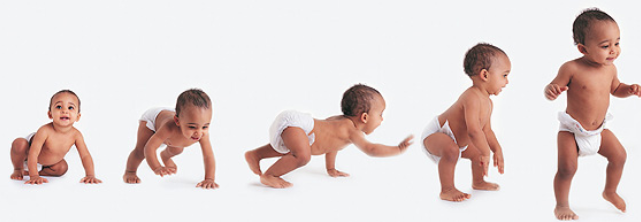Early motor learning
From the very beginning, the brain has an intrinsic motivation to learn and organize itself. For this purpose, sensory impressions or experiences are processed, evaluated according to certain patterns and stored. During this early learning, connections in the brain multiply explosively until a complex neural network gradually emerges.
Content
Life begins with learning, even before birth. The exact origin of this early learning is still largely unknown. In the brain, most of the nerve cells already exist at this point, but not the multiple functional connections required between neurons, as the brain is not yet trained. However, even at such an early stage, there must already be a systemic learning program anchored in the brain itself: from the very beginning, the brain has an intrinsic desire to learn and organize itself. For this purpose, sensory impressions or experiences are processed, evaluated according to certain patterns and stored. During this early learning, connections in the brain multiply explosively until a complex neural network gradually emerges.
Basic principles of motor development
The development of motor skills follows certain basic principles:
Cerebrospinal caudal
Development from head to toe. The head develops earlier than the motor skills of the hand, and the hand develops earlier than the legs and feet.
Proximo-distal
The movement of the limbs closer to the body develops before the limbs further away, that is, from the trunk, shoulders, arms to the hands and fingers.
Coarse-fine
From large and imprecise movements to small and more precise movements. This development parallels proximo-distal development, for example in grasping objects.
Sequentially
Many of these motor learning processes occur in a functional sequence, even though there are individual differences in the expression of the various phases. Certain movement patterns precede other movements: When learning to walk, babies gradually go through different phases of turning onto their stomachs, straightening their heads, crawling, standing up, first steps to walking.

basal movement patterns
However, in early childhood, basic "skills" such as grasping are already learned, but they go beyond the simple execution of movements and include important aspects of action, such as understanding object properties and object use.

Grasping, object use
Intrinsic motivation
These intrinsically determined early learning processes are normally very successful, even though there may be differences in developmental speed and skills. It appears that the intrinsic drive is sufficient in children to acquire these necessary skills, such as walking, grasping, speaking, to cope later in everyday life. In the absence of a physical impairment, all children will acquire these basic motor skills. Therefore, the presence of a teacher is not in itself responsible for the success or failure of a learning process. Many children also learn from other children who are already a step ahead in their development. In early motor learning, so-called mirror neurons also initially help to translate movements observed in others into mirrored internal motor actions. Imitation of observed movements thus initiates the learning of many movements. However, what is known from research results is that these learning processes can be severely impaired if the learning environment is severely reduced. At least at this early stage, the presence of an appropriate learning environment appears to be more important to the learning system than the presence of a teacher.
What does this mean for my teaching practice?
Early motor learning always develops from large to small joints and from coarse to fine. This can be seen, for example, in the case of the acquisition of handwriting. At first, large strokes from the larger joints are used, and even a coarser pencil is useful. As movement proficiency increases, the movements become smaller and more coordinated, and the pencil should also become finer and finer.
Reflection question
How can a young child learn in a self-organised way right from the start and thus virtually programme itself, even though the brain is still barely networked at this point?
Quiz
1) Early childhood learning
A) needs a teacher
B) is self-organising
2) Motor learning in children
A) follows a specific functional sequence
B) is organised differently in each child